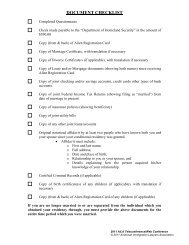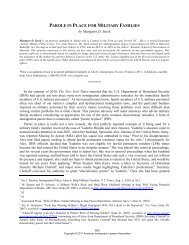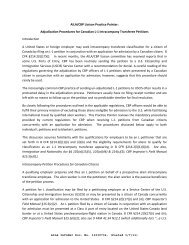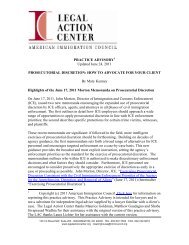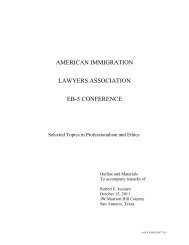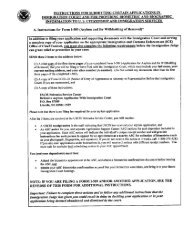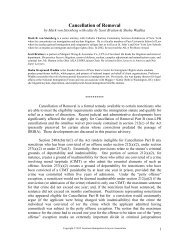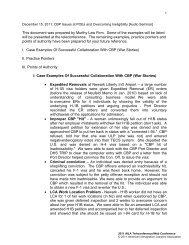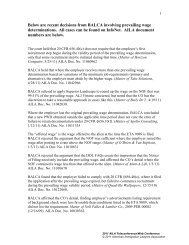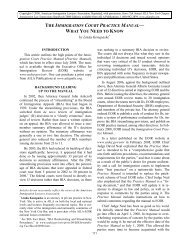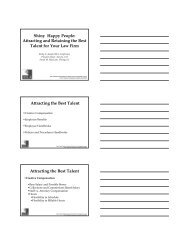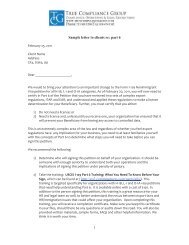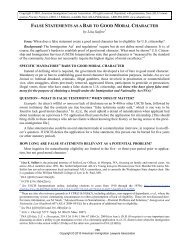Immigration Practice Pointers, 2010-11 Ed. - AILA webCLE
Immigration Practice Pointers, 2010-11 Ed. - AILA webCLE
Immigration Practice Pointers, 2010-11 Ed. - AILA webCLE
You also want an ePaper? Increase the reach of your titles
YUMPU automatically turns print PDFs into web optimized ePapers that Google loves.
PM-602-0017: Subject New INA Section 204(l) –<br />
Approval of Petitions and Applications after the Death of the Qualifying Relative<br />
AFM Update 10-51<br />
Page 5<br />
The new section 204(l) does not expressly define the “qualifying relative.” From the<br />
list of aliens to whom new section 204(l) applies, USCIS infers that “qualifying relative”<br />
means an individual who, immediately before death was:<br />
<br />
<br />
<br />
<br />
<br />
<br />
The petitioner in an immediate relative or family-based immigrant visa petition<br />
under section 201(b)(2)(A)(i) or 203(a) of the Act;<br />
The principal beneficiary in a widow(er)’s immediate relative or a family-based<br />
visa petition case under section 201(b)(2)(A)(i) or 203(a) of the Act;<br />
The principal beneficiary in an employment-based visa petition case under<br />
section 203(b) of the Act;<br />
The petitioner in a refugee/asylee relative petition under section 207 or 208 of the<br />
Act;<br />
The principal alien admitted as a T or U nonimmigrant;<br />
The principal asylee, who was granted asylum under 208 of the Act.<br />
Section 204(l) applies to a petition or application adjudicated on or after October 28,<br />
2009, even if the qualifying relative died before October 28, 2009. If a petition or<br />
application was denied on or after October 28, 2009, without considering the effect of<br />
section 204(l), and section 204(l) could have permitted approval, USCIS must, on its<br />
own motion, reopen the case for a new decision in light of section 204(l). See chapter<br />
10.21(c)(8) of this AFM for guidance on cases denied before October 28, 2009.<br />
Section 101(a)(33) of the Act governs the determination whether an alien “resided”<br />
in the United States when the qualifying relative died, and whether the alien continues<br />
to reside in the United States. A person’s “residence” is his or her “principal, actual<br />
dwelling place in fact, without regard to intent.” If the alien’s “residence” was in the<br />
United States at the required times, the alien “resided” here. The statute does not bar<br />
an alien who was actually abroad when the qualifying alien died from proving that the<br />
alien still resides in the United States. Also, section 204(l) of the Act does not require<br />
the alien to show that he or she was, or is, residing here lawfully. Execution of a<br />
removal order, however, terminates an alien’s residence in the United States.<br />
Sections 203(d), 207(c)(2)(A), and 208(b)(3)(A) permit the spouse or child of a<br />
principal alien to accompany or follow to join a principal alien. If any one beneficiary of<br />
a covered petition meets the residence requirements of section 204(l) of the Act, then<br />
the petition may be approved, despite the death of the qualifying relative, and all the<br />
beneficiaries may immigrate to the same extent that would have been permitted if the<br />
qualifying relative had not died. But it is not necessary for each beneficiary to meet the<br />
residence requirements in order to have the benefit of section 204(l).<br />
(2) Widow(er)s of Citizens. As stated in paragraph (b) of this chapter, section 204(l)<br />
does not apply to a Form I-130 filed by a now-deceased citizen on behalf of his or her<br />
spouse. Because of the automatic conversion of the Form I-130 to a Form I-360, there<br />
<strong>AILA</strong> InfoNet Doc. No. <strong>11</strong>0<strong>11</strong>061. (Posted 01/10/<strong>11</strong>)



